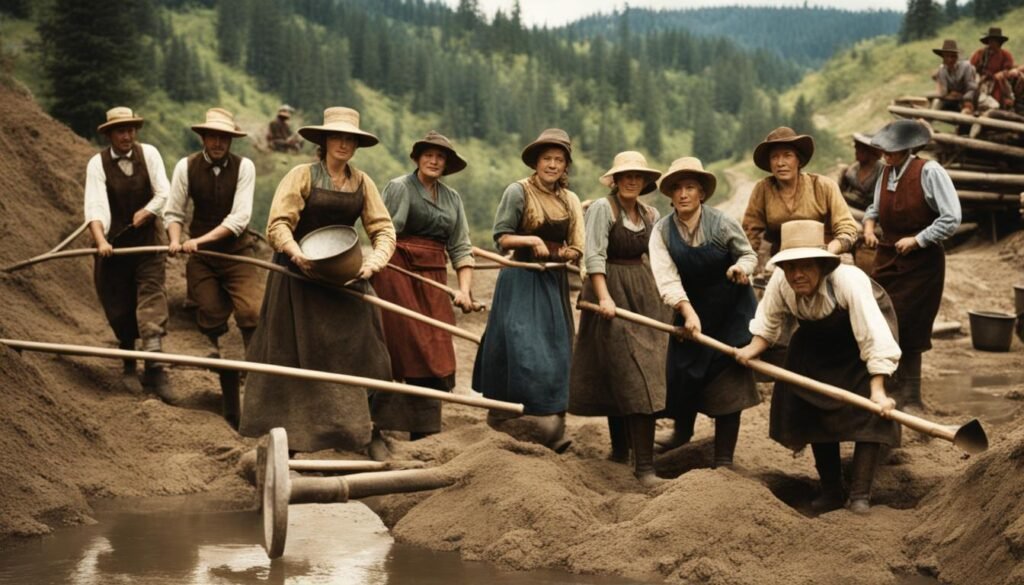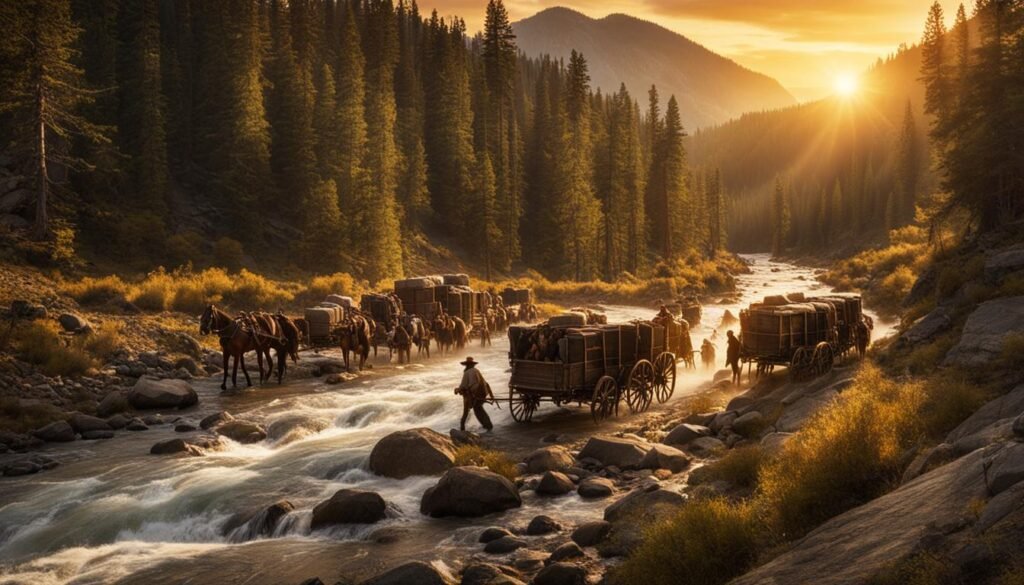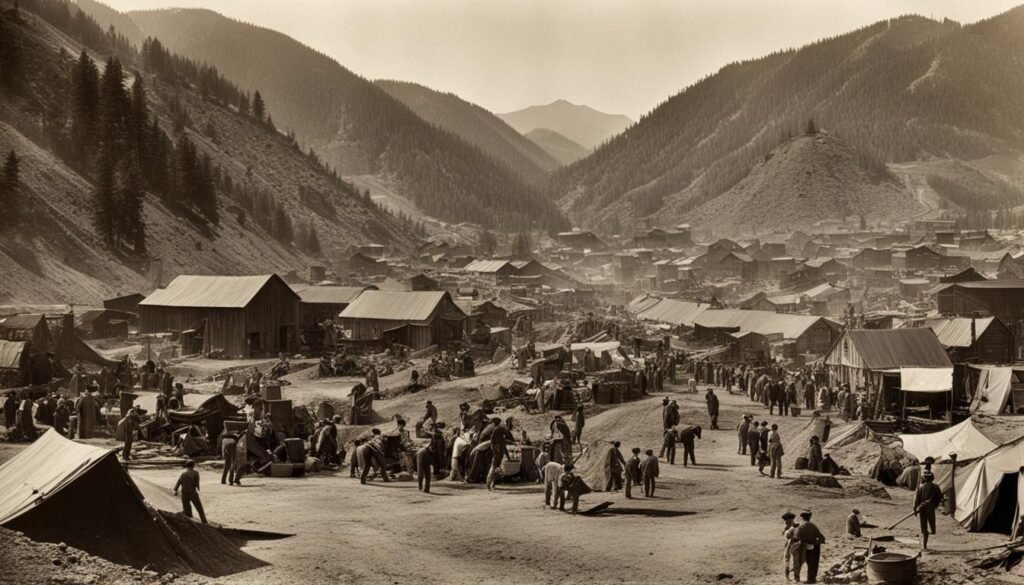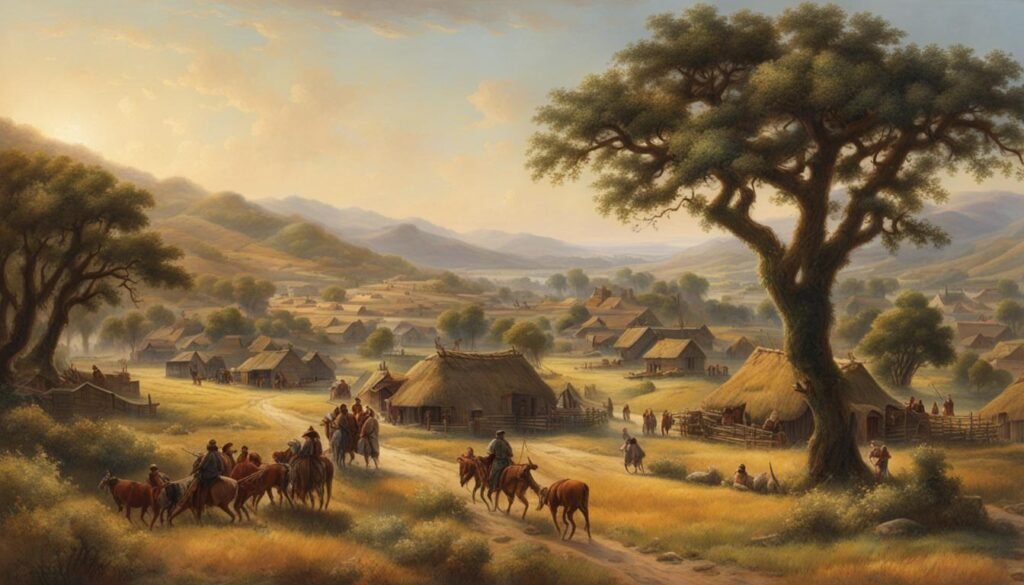Join me on a journey back in time to the exhilarating days of the California Gold Rush, also known as the Forty-Niners Gold Rush. This remarkable chapter in American history saw a wave of gold fever sweep the nation, as people from all walks of life set out on an epic quest to strike it rich and change their lives forever.
The lure of gold was irresistible, and soon, thousands of gold seekers, known as Forty-Niners, embarked on treacherous journeys to reach the gold fields of California. They braved perilous routes, including the overland trail through the Sierra Nevada mountains and the tumultuous voyage around Cape Horn. Others opted for the Panama Shortcut, sailing to Panama and then continuing their journey to the bountiful land of gold.
During the gold rush era, gold mining activities thrived, fueling rapid westward expansion and the growth of bustling mining towns. Everyone, driven by the intoxicating gold fever, dreamt of striking it big and forever changing their fortunes. But this era was not just about the pursuit of wealth; it was a transformative period that altered the course of American history.
Key Takeaways:
- The California Gold Rush, also known as the Forty-Niners Gold Rush, captured the nation’s attention and ignited a frenzy for wealth and adventure.
- Thousands of people, known as Forty-Niners, set out on an epic quest for gold, hoping to strike it rich and change their lives forever.
- The gold rush era marked a period of rapid westward expansion and a boom in gold mining activities, as people from all walks of life were consumed by gold fever.
- The journey to the gold fields of California was filled with different routes and modes of transportation, each with its own challenges and opportunities.
- The impacts of the gold rush are still visible in California’s history and landscape today.
Routes to the Gold Rush
The journey to the California Gold Rush was an adventure riddled with different routes and modes of transportation. As thousands of hopeful Forty-Niners set out to seek their fortunes, they faced the choice of taking various paths to reach the coveted gold fields of California.
One option was the overland route, which traversed treacherous terrains such as the Sierra Nevada mountains. This route required great perseverance and endurance, as miners braved harsh conditions and rugged landscapes to reach their destination.
Another route taken by some intrepid prospectors was the Cape Horn route. This involved sailing around the treacherous Cape Horn, facing the perils of the open sea. It was a risky yet potentially quicker route for those seeking a shortcut to the gold fields.
The Panama Shortcut offered yet another alternative. This route involved sailing to Panama, crossing the isthmus, and then continuing the journey to California. While it provided a more direct path, travelers still had to face the challenges of navigating unfamiliar territories and dealing with the logistics of crossing the isthmus.
Each of these routes had its own set of challenges and opportunities, attracting different types of adventurers to the gold rush. Whether by land or sea, they all shared the same burning desire to uncover the wealth waiting in the gold fields of California.
So, picture the scene: brave Forty-Niners embarking on perilous journeys, traversing mountains or braving the open ocean. Their destination? The promised land of gold. It was an era of excitement and possibility, where dreams were pursued and fortunes were made.
Continue reading to learn more about the people who made up the Forty-Niners and their journey to the gold rush.
Who were the Forty-Niners?
The California Gold Rush of the 19th century attracted a diverse group of individuals from all over the world. Known as the Forty-Niners, these men came from various professions, including miners, farmers, merchants, and professionals like doctors and lawyers. They were driven by the promise of wealth and adventure, hoping to strike it rich in the gold fields of California.
But the gold rush era was not just dominated by men. Women also played a significant role in the development of the mining towns in the American West. Many women moved west to join their husbands, who were searching for gold. Others traveled on their own, seeking economic opportunities and a chance to build a better life. These women faced unique challenges in the male-dominated mining towns but made lasting contributions to the development of nineteenth-century western society.
Despite the harsh living conditions and limited rights, women in mining towns worked as cooks, laundresses, boardinghouse operators, and sometimes even as miners themselves. Their hard work and resilience helped shape the social fabric of these mining communities.
In addition to their contributions to the mining towns, women moving west during the gold rush era challenged traditional gender roles and paved the way for future generations of women seeking independence and empowerment.
The Forty-Niners and the women who accompanied them on their journey were driven by various motivations. Some sought wealth and adventure, while others were escaping difficult living conditions in the East or seeking new opportunities in the ever-expanding West. Their stories are a testament to the spirit of exploration and determination that defined the gold rush era.
Transportation in the Gold Rush
The California Gold Rush of the 1840s brought about a massive influx of settlers, all eager to seek their fortunes in the wild west. As the population swelled, transportation became a crucial aspect of the gold rush era. To accommodate the growing demand, transportation networks were established, providing vital connections between the gold fields and the rest of the country.
Roads
One of the primary forms of transportation during the gold rush was the development of roads. These roads provided access to the gold fields and facilitated the movement of people and supplies. Pioneers faced numerous challenges while constructing these roads due to the rugged terrain and harsh conditions. Despite the difficulties, the transportation infrastructure created during this time played a vital role in enabling gold rush migration.
Stagecoaches
Stagecoaches quickly became a popular mode of transportation during the gold rush. These sturdy horse-drawn vehicles offered a faster and more comfortable way to travel long distances. Stagecoach routes were established, connecting the major mining towns and facilitating trade and communication. Passengers would endure bumpy rides and treacherous roads, but the stagecoach provided a vital lifeline for the gold rush pioneers.
Steamboats
Waterways played a crucial role in transporting people and supplies during the gold rush. Steamboats navigated the rivers and provided a faster and more efficient means of transportation. These steam-powered vessels transported goods and passengers up and down the California coast, connecting the gold fields with major cities. Steamboats not only facilitated trade but also supported the development of coastal towns and cities.
Overall, transportation in the gold rush era was instrumental in supporting the massive influx of settlers and the migration of the Forty-Niners. Roads, stagecoaches, and steamboats formed vital links between the gold fields and the rest of the country, shaping the history of California and leaving a lasting legacy of the epic quest for wealth in the wild west.
Women in the Gold Rush
The presence of women in nineteenth-century western mining towns during the gold rush was significant. While men dominated the mining industry, women played essential roles in supporting the mining communities. They worked as cooks, laundresses, boardinghouse operators, and sometimes even as miners themselves.
Women moved west for various reasons, including seeking economic opportunities, escaping difficult living conditions in the East, or joining their husbands. Their contributions to the gold rush era challenged traditional gender roles and influenced the development of mining towns.
Women’s Roles in Mining Towns
- Cooks: Women played a crucial role in providing meals to the miners. They cooked delicious and satisfying meals, often under challenging circumstances, to keep the miners well-fed and energized.
- Laundresses: These hardworking women took care of the miners’ laundry, ensuring clean and fresh clothes despite the rugged conditions of the mining towns.
- Boardinghouse Operators: Many women ran boardinghouses, providing a home away from home for the miners. These boardinghouses offered meals, beds, and a community atmosphere where miners could relax and socialize.
- Miners: While the majority of miners were men, some women also took on the challenging work of mining. They could be seen wielding picks and shovels alongside their male counterparts, eager to find their own fortune.
The determination and resilience of these women brought a sense of stability and comfort to the male-dominated mining communities. They also provided a glimpse into the changing roles and opportunities for women in the nineteenth century.
Reasons for Moving West
Why did women venture west to the mining towns? There were several reasons that motivated them:
- Economic Opportunities: The gold rush created a surge in demand for goods and services, providing women with opportunities to earn money. By moving west, they could establish their businesses and capitalize on the needs of the growing mining communities.
- Escape from Difficult Living Conditions: Many women saw the journey westward and the gold rush as a chance to escape poverty, harsh living conditions, or limited opportunities in the East. They sought a fresh start and better prospects for themselves and their families.
- Joining Husbands: Women whose husbands had already joined the gold rush often followed them to the mining towns. They sought to reunite with their loved ones and support them in their pursuit of wealth.
The gold rush era presented women with new possibilities and the chance to challenge societal norms. Their brave decision to move west and contribute to the mining towns’ development left a lasting legacy and helped shape the history of the American West.

Impacts of the Gold Rush
The California Gold Rush had a profound impact on society, the economy, and the environment. The discovery of gold in California marked a pivotal moment in history, transforming the region from a sparsely populated frontier into a thriving and prosperous state.
One of the key impacts of the gold rush was the rapid growth of cities. As thousands of fortune-seekers flocked to California, towns sprang up overnight to accommodate the influx of miners and merchants. San Francisco, in particular, experienced a dramatic population surge, evolving from a small trading post into a bustling metropolis.
The gold rush also spurred the expansion of industries. As mining operations flourished, various sectors emerged to support the needs of the gold miners. Businesses catering to mining supplies, tools, banking, and entertainment thrived, providing employment opportunities and contributing to the overall growth of the economy.
Moreover, the development of infrastructure was a significant effect of the gold rush. The need for transportation, communication, and housing prompted the construction of roads, bridges, telegraph lines, and buildings. The expansion of infrastructure not only facilitated the movement of people and goods but also paved the way for further development in California.
However, the gold rush also had negative consequences, particularly on the environment. Extensive mining practices, such as hydraulic mining, resulted in massive alterations to the landscape. Entire hillsides were washed away, rivers were polluted with sediment, and ecosystems were disrupted. The environmental damage caused by the gold rush had long-lasting effects on California’s biodiversity and natural resources.
Furthermore, the gold rush led to the displacement of Native American communities. As miners encroached upon Native American lands in search of gold, conflicts and tensions arose. Native Americans were often forced off their ancestral territories, leading to the loss of their lands, culture, and livelihoods.
The impacts of the gold rush are still evident in California today. The state’s rich history, urban landscapes, and ongoing environmental conservation efforts serve as constant reminders of the transformative era that shaped the Golden State.
Mining in the 19th Century
The gold rush era saw a significant boom in mining activities throughout the United States. Gold mining became a dominant industry in the 19th century, attracting individuals from diverse backgrounds and regions. People were captivated by the allure of striking it rich through mining ventures. During this period, mining techniques evolved as new technologies and methods were developed to extract gold from the earth.
One of the major catalysts for the mining boom in the 1800s was the California Gold Rush, which drew thousands of fortune seekers to the West Coast in search of golden opportunities. This mass migration not only fueled economic growth but also shaped the nation’s history. The discovery of gold in California established it as a coveted destination and sparked a frenzy of gold mining activities.

Gold mining became synonymous with the American Dream and the pursuit of wealth and success. The prospect of striking gold inspired countless individuals to embark on perilous journeys, braving treacherous terrains and harsh conditions in the hopes of finding their fortunes. It was a time of adventure, risk-taking, and the relentless pursuit of prosperity.
The mining boom in the 1800s played a pivotal role in the economic development of the country. It spurred the growth of towns and cities near gold mining sites, attracting merchants, entrepreneurs, and various industries that supported the mining operations. The influx of people seeking their fortunes contributed to westward expansion and the shaping of the American frontier.
Key Points:
- The gold rush era witnessed a boom in mining activities across the United States, with gold mining becoming a prevalent industry in the 19th century.
- New technologies and methods were developed to extract gold from the earth during this period.
- The California Gold Rush was a major catalyst for the mining boom in the 1800s, drawing fortune seekers from all over the country.
- Gold mining became synonymous with the American Dream and the pursuit of wealth and success.
- The mining boom contributed to the economic growth of the country, shaping its history and leading to westward expansion.
Conclusion
The Forty-Niners Gold Rush, with its explosive mining boom and the promise of newfound wealth, epitomized the daring spirit of westward expansion during the 19th century. As pioneers rushed to California in search of gold, their quest for prosperity forever shaped the course of American history. The gold rush era brought about significant effects, transforming not only the state of California but also the entire nation.
From the economic standpoint, the gold rush triggered a rapid expansion as towns and cities sprung up almost overnight. The influx of settlers led to a surge in westward migration, fueling the ideals of manifest destiny and manifesting the United States’ destiny to expand across the continent.
The gold mining frenzy had a profound impact on the social fabric of the time. Women played a crucial role in supporting the mining communities, challenging traditional gender roles and contributing to the development of nineteenth-century western society. Immigrants from all corners of the globe also flocked to California, helping to shape a rich and diverse culture that still exists today.
However, the gold rush wasn’t without its downsides. Intensive mining practices caused considerable environmental damage, disrupting ecosystems and leaving scars on the landscape that persist to this day. Native American communities were displaced and marginalized as their ancestral lands were seized for mining activities.
The legacy of the Forty-Niners Gold Rush lives on, reminding us of the resilience and determination of those who risked everything in pursuit of their dreams. It is a testament to the indomitable spirit of westward expansion, and the relentless pursuit of the American Dream. The gold rush era continues to captivate our imaginations, ensuring that this pivotal chapter in American history will never be forgotten.
FAQ
What was the California Gold Rush of 1849?
The California Gold Rush of 1849, also known as the Forty-Niners Gold Rush, was a significant event in American history. It was a period of rapid westward expansion and a boom in gold mining activities, as people from all walks of life were consumed by gold fever.
What were the different routes to the gold rush?
Some Forty-Niners traveled by land, taking the overland route through treacherous terrains such as the Sierra Nevada mountains. Others sailed around Cape Horn, facing the dangers of the open sea. Another popular route was the Panama Shortcut, where travelers sailed to Panama, crossed the isthmus, and then continued their journey to California.
Who were the Forty-Niners?
The Forty-Niners were a diverse group of individuals drawn to the California Gold Rush from all over the world. They included men from various professions, such as miners, farmers, merchants, and even professionals like doctors and lawyers. Women also played a significant role in the gold rush era, as they moved west to join their husbands or seek opportunities for themselves.
How did transportation play a role in the gold rush?
The California Gold Rush triggered a massive influx of settlers into the region, making transportation a crucial aspect. Transportation networks were established, including roads, stagecoaches, and steamboats, to facilitate the movement of people and supplies. These modes of transportation supported the migration of Forty-Niners and the development of the gold rush towns.
What role did women play in the gold rush?
Women in nineteenth-century western mining towns faced unique challenges but contributed to the development of the communities. They worked as cooks, laundresses, boardinghouse operators, and even miners themselves. Women moved west for various reasons, including seeking economic opportunities, escaping difficult living conditions in the East, or joining their husbands.
What were the impacts of the gold rush?
The discovery of gold during the California Gold Rush transformed the state from a sparsely populated frontier to a bustling and prosperous state. It led to the rapid growth of cities, the expansion of industries, and the development of infrastructure. However, it also had negative consequences, such as environmental damage and the displacement of Native American communities.
What was mining like in the 19th century?
The mining boom in the 1800s brought about a prevalence of gold mining across the United States. It attracted people from different backgrounds and regions. Mining techniques evolved with new technologies to extract gold from the earth. Gold mining became synonymous with the American Dream and the pursuit of wealth and success.
What was the significance of the gold rush era?
The Forty-Niners Gold Rush symbolized the spirit of westward expansion, manifest destiny, and the pursuit of wealth. It transformed California and had a profound impact on the nation’s economy, society, and culture. The legacy of the gold rush includes mining, immigration, and the pursuit of the American Dream.







